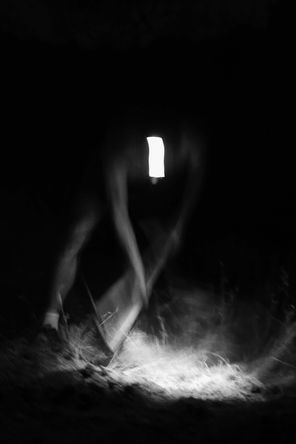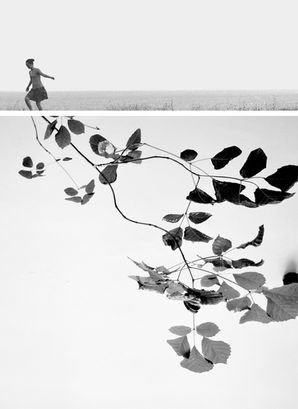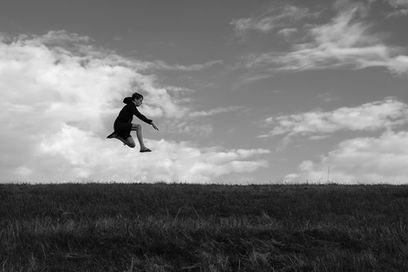
LIFE IN BETWEEN
June 3, 2022
INTERVIEW
PHOTOGRAPHY Vicky Markolefa
STORY Vicky Markolefa
INTERVIEW Karen Ghostlaw Pomarico
LIFE IN BETWEEN explores the interface of man and the sea world. The project documents the impact of human activities on the marine and coastal environment in the Mediterranean with a human-centric approach.
Humans and marine life have coexisted for eons. During the past decades, the world's seas and oceans have suffered from immense pressures and undergone rapid changes which have affected humans and marine ecosystems in multiple ways. Plastic pollution, unregulated coastal development, excessive tourism, depleted fish stocks and the climate crisis, are key threats to our future.
I have been witnessing these realities first hand, documenting the changing landscapes and the challenges of the people who depend on the seas for their survival. Through my collaboration with leading environmental organizations I documented these topics through a wide spectrum which engulfed research and monitoring activities, onsite interventions, rehabilitation and capacity building and awareness raising.

“This is a theme very close to my heart and mentality. In this project, I emphasise on profiling leading female scientists and conservationists. Throughout my visual work, female representation is a priority, as I share the long term commitment to promote women's rights through photography. With this project I hope to contribute to a more inclusive and direct dialogue on nature conservation.”
IN CONVERSATION WITH VICKY MARKOLEFA
In this interview, we ask Vicky about her perspective on the power of photography and the impact it has had in the world of conservation.
THE PICTORIAL LIST: Vicky please tell us about your geological location on the Mediterranean that your visual essay examines.
VICKY MARKOLEFA: The project spans in four Mediterranean countries: Greece, Albania, Turkey, and Tunisia and covers several locations. I felt it was important to follow the story in different locations, to point out the common points that exist. LIFE IN BETWEEN approaches our relationship with the marine world in the Mediterranean, one of the most touristic and densely inhabited places on the planet. From busy, industrial ports to picturesque villages, and from rocky coastlines to endless stretches of sand and pristine marine protected areas, this is the amazing and ever-changing landscape of the Med. But its soul is in its people, and that is what is slightly different about this project.
TPL: Explain the visual investigation you engaged in your studies on human activities and their impact on the marine and coastal environments in the Mediterranean. Describe to us your human-centric approach.
VM: I feel strongly that if we are to understand the impact of our actions on the natural world and on ourselves, we should somehow engage with the topic on a deeper, experiential level. Through ‘Life In Between’ I tried to approach the subject from a human perspective and through the stories of the people who live at sea and from the sea, the people who are on the first line of conservation, and most importantly people whose emotional world I could somehow grasp inside an image. ‘Life In Between’ questions our stance on the evident, existential problem that we are dealing with.
TPL: Tell us about the importance of the community of women scientists and conservationists you have engaged, and the important contributions they are making.
VM: You know, there is a dark side in almost everything. Conservation is no exception. I believe that the reason that the environment suffers so much from manmade pressures is why we and our societies suffer. Patriarchy, unequal power relations, detachment. Hence my interest in profiling female scientists in this project, showcasing their work, and their contribution. And, perhaps, some influence from ecofeminism. I feel even more motivated when I meet change-makers who live and work in remote and disadvantaged areas, such as a small port off the coast of Tunis, Cap Zebib. There I met Amal, a young scientist who overcomes the bias in her community and thrives working as a fisheries observer for the MedBycatch project. These are the stories that show us that a new collaboration scheme is possible. A participatory system where local communities are at the forefront and heart of environmental actions. Imagine an open circuit in which science and policy are informed and improved by encompassing and allowing local experience and new ideas to claim their rightful place.
TPL: Talk to us about June Haimoff, and her contribution to your project.
VM: Kaptan June (June Haimoff) was an English environmentalist who lived in Dalyan in Turkey. In mid 80’s she and other environmentalists launched a successful campaign to preserve İztuzu Beach as a habitat for the endangered Caretta caretta sea turtle and prevent the building of a huge hotel. This beach is protected until today and is one of the main nesting places of the species in Turkey and the Mediterranean. I met Kaptan June while filming the documentary ‘My Name Is Blue’ and I had the honor to be granted one of her last interviews. Unfortunately, she passed away recently.
Extract from her interview -
"You know, I am a romantic. I love beautiful things and travel and such.
I came on a boat, I was a sailor. And I found this place, I don’t know how. I guess it was meant to be.
I can sing and dance, I was a singer and a dancer. I didn’t have a degree in beach conservation or anything. But, you see, I have a heart!
Our beach was untouched when I first came here. You know what happens to coasts around the world these days. They get developed. Roads come and more buildings.
It’s part of my purpose in life, the protection of this beach together with other people. One person alone couldn’t have done it. But I shouted, I spoke, I said…. And what happened? They began to listen.
Oh, love. A lot of things wouldn’t have happened without love."
June Haimoff, July 2021, Dalyan Turkey
Kaptan June Sea Turtle Conservation Foundation
My Name Is Blue Documentary (created by Mind The Bump Productions, Directed by Bastian Fischer et moi)
TPL: With this project you say you “hope you contribute to a more inclusive and direct dialogue on nature conservation.” Explain this in more detail for us.
VM: There’s lots of tiptoeing around conservation topics obviously for political reasons. But even on a daily, personal level too. Our language for example is a key point in this discussion. We often refer to Nature as ‘resources’, which is translated as ‘a pot out of which we can grab anything we need.’ We know well by now that there is nothing beneficial in using this word to describe Nature, and in treating it like this either. These words became values and through repetition and practice, they are the norm. We didn’t always think or act this way, self-destructively. I come from Arcadia in the mountainous Peloponnese. There, the Arcadian ideal used to prevail in people’s lives. The concept that the Human cannot surpass the total and the Natural. It flows with it, not against it.
I refer to the kind of approach in which Nature’s intrinsic value is recognized, independently of whether it satisfies human needs or not. Inclusivity that expands from the human scale. Direct approach, yes. Dialogue and informed decision-making not only on an institutional level but also openly, on the ground, from the bottom, up.
TPL: Tell us about the supporting veterinarians and clinics that support your efforts.
VM: There is a limited network of rescue centers around the Med. They are few and certainly not enough to cope with the thousands of animals that need their help. I had the chance to document the work of Dr. Koray Kabadayıoğulları, veterinarian at DEKAMER Sea Turtle Research and Rehabilitation Center in Turkey. He and his teams work throughout the summer, often long hours and in stretching conditions, to care for the many sea turtles hosted in the center and care also for the ones sent by nearby areas. His work is lifesaving and his commitment humbling. It’s in the paradigm of these low-profile heroes that I find the courage to further pursue my work. Thank you for the inspiration, Koray.
Imagine an open circuit in which science and policy are informed and improved by encompassing and allowing local experience and new ideas to claim their rightful place.

TPL: Give us a little history on the sea turtles you have documented and what the dangers are, and what are your goals to help them?
VM: I have been working on this topic for quite some time and in the process, I think I have seen sea turtles in several states of being, from really bad, to coping, to chilled, I think at least.
Midas, is a green turtle that (most probably due to entanglement in fishing gear) lost both his front flippers and damaged his eye. With limited vision and swimming skills, Midas will have serious problems surviving in the wild. He hasn’t reached the age to mate, he hasn’t had a chance to even become an adult. He swims back and forth in his tank, all day long. It’s at least disheartening to see this wild creature, whose life is all about roaming the open seas trapped in this fate because of human negligence. It is even more unfair if we consider that we know what causes these cases and we know what it takes to mitigate them.
Experts say that the most common threats for sea turtles are manmade and include entanglement in abandoned fishing gear and bycatch, pollution, loss of habitat, and climate change. Illegal trade is also a big threat, and one hard to tackle. As for the causes of injury and death, among the top ones are plastics ingestion, ecotoxicological problems and, boat collisions.
TPL: Tell us about the documentary journey you are on, share with us the multitude of organizations you have engaged and worked with through your collaborations.
VM: For this project, certain images have been produced while documenting the work of leading experts through regional and international marine conservation projects: 'Mediterranean Cleanup', ‘Plastic Busters MPAs’, ‘MedByCatch’ and ‘Conservation of Marine Turtles in the Mediterranean Region’. I am grateful for their cooperation.
I started taking pictures in adolescence with my father's camera (thank you Dad!) and never stopped. Since 2006, I work professionally in documentary visual storytelling, reportage and communication projects for leading institutions, organisations and media and independently. This journey has nurtured me, offered me interesting experiences and valuable moments for which I am grateful for.
TPL: How has this affected the local communities and what is the impact on their daily lives? Describe the social consequences you are witnessing. Is it possible to create change, and if so, how?
VM: The degradation of our marine ecosystems can only have negative impacts, limiting our ability to survive and in doing so in a sustainable way. Overfishing for example, is a key threat to food security in Europe, as we import the vast majority of our fish and seafood. Small-scale fishers struggle to make ends meet. Coming from Greece, where the traditional vessels are disappearing to large-scale fleets, we witness the loss of parts of our cultural identities as well. These are the elements that define who we are. Fundamental aspects of our lives are changing faster than we can grasp. Tourism for example is a key source of income for the Mediterranean but also a reason behind loss of habitat for species. We rely heavily on the amazing climate and our ecosystem which offer us the prospect of a great quality of life. Yet, we daily consume so much, and a lot of single-use plastics which we then don’t recycle and dispose of properly. We continue to produce plastic packaging in tons. The Med, apart from home to hundreds of millions of people, also serves as a large corridor for transport and is also a field of research for oil and gas. It’s a lot for such a relatively small place, wouldn’t you say?
Change is the only constant they say. The question is: what we are changing on to. Is it a decision we can make ourselves, alone?
Many of us act on a daily level and try to adapt, live more sustainably, shop locally and responsibly, recycle, and advocate for political change. In my opinion, our view of ourselves and the world is kind of obsolete. It’s a long conversation, one that involves a talk about religion as well.
TPL: Are the local communities receptive to the efforts and do they join in the alliance to make these changes?
VM: Grassroots knowledge has informed conservation practices for years. It is where that is not happening, that we see the major declines. Take the Amazon for example and the land grabs issues. Take also the Masai Mara paradigm where preventive fire is used to create zones in the savannah. In my view, the adaptation stress lies mostly with the decision makers, and academics and the scientists, the fields which are also more prone to top-down approaches, and politically driven. If only we had involved to the locals earlier and more carefully. The adaptation capacity of local communities is also limited, due to the way we approach adaptation as well, how and why we design the strategies we apply. It’s never too late o adopt conservation as a part of common daily life.
TPL: What are some short and long term goals?
VM: There are exhibitions and publications planned for the next months, where I hope I will have the chance to discuss more these issues. In the long run, I would like to continue working on documentary projects of such scale and orientation and publish my first photobook.
Thank you very much for this opportunity!
Vicky Markolefa is a visual storyteller and media expert based in between Greece and Germany, working independently and worldwide with organisations since 2016. Vicky specialises in documentary photography and film production with a focus on social and environmental topics. Her portfolio features partnerships with institutions such as the United Nations, the European Commission, and leading organisations such as WWF and Medecins San Frontieres. Vicky's projects have received recognition at international awards, festivals, and exhibitions. Vicky co-founded the productions house Mind The Bump in 2016, where she works as a documentary director and producer. She also is part of the team at BULB Photos/Balkan Collective and also founded Women Photo Greece, the first online community in Greece dedicated to promoting equal participation of female, non-binary and LGBTQIA+ individuals in photography.
Views expressed in this interview are solely Vicky Markolefa's and do not represent the views of the organizations or individuals mentioned.
Certain images have been produced while documenting the work of leading experts through marine conservation projects "Mediterranean Cleanup", ‘Plastic Busters MPAs’, ‘MedBycatch’ and ‘Conservation of Marine Turtles in the Mediterranean Region’ (Specially Protected Areas Regional Activity Center (SPA/RAC) of the United Nations Environment Programme/Mediterranean Action Plan (UN Environment/MAP), Agreement on the Conservation of Cetaceans of the Black Sea, Mediterranean Sea and contiguous Atlantic area (ACCOBAMS), General Fisheries Commission for the Mediterranean (GFCM), International Union for Conservation of Nature – Centre for Mediterranean Cooperation (IUCN-Med), BirdLife Europe and Central Asia, Mediterranean Association to Save the Sea Turtles (MEDASSET), World Wildlife Fund (Mediterranean Marine Initiative), MedPAN, DEKAMER, WWF Tunisia, WWF Greece, WWF Turkey, ARCHELON, National Marine Park of Zakynthos, Hellenic Center for Marine Research, Enaleia.)

Vicky Markolefa's project is a powerful reminder of the fragility of our oceans and their inhabitants. Through her photography and film production, she has beautifully captured the beauty and importance of our marine environment, as well as the potential danger of failing to protect it. By engaging with her work, we gain valuable insight into the impact of human activities on the Mediterranean Sea and beyond.




































